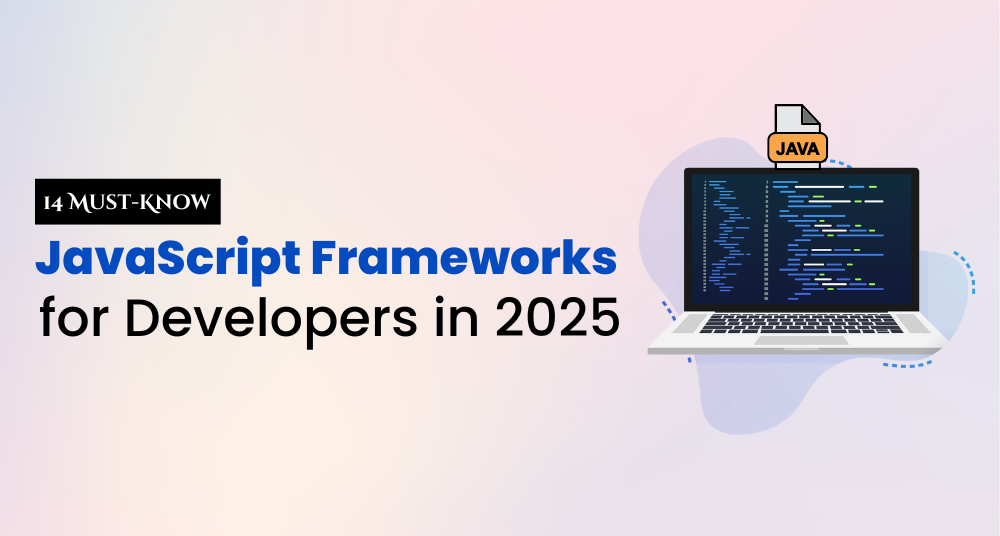JS Frameworks: Powering Modern Web & App Development
JavaScript remains the backbone of web and mobile application development, enabling developers to create interactive, high-performance solutions. From powering global platforms like Netflix, Spotify, LinkedIn, and Uber to simplifying development workflows, JavaScript frameworks play a crucial role in modern software engineering.
With numerous frameworks available, choosing the right one can significantly impact scalability, performance, and user experience. In this guide, we explore the top JavaScript frameworks of 2025, helping developers and businesses make informed decisions for their projects.
Key Takeaways
- JavaScript frameworks provide a structured approach to coding.
- They help build scalable, high-performance applications.
- React, Angular, and Vue.js remain top choices for developers.
- The right framework enhances speed, maintainability, and security.
- 2025 brings new innovations in JavaScript development.
JavaScript Frameworks vs. Libraries: What’s the Difference?
When developing modern web and mobile applications, developers often rely on JavaScript frameworks and libraries to streamline the process. While both serve as valuable tools, they differ in their structure, usage, and flexibility.
What is a JavaScript Library?
A JavaScript library is a collection of pre-written functions that help developers perform specific tasks without writing code from scratch. Libraries provide reusable components that simplify development, allowing developers to maintain control over the application’s structure.
What is a JavaScript Framework?
A JavaScript framework provides a structured environment for building applications. Unlike libraries, frameworks dictate the architecture and workflow, offering built-in solutions for UI components, state management, and routing.
Key Differences: Frameworks vs. Libraries
Control: Libraries offer flexibility, while frameworks enforce a specific structure.
Usage: Libraries assist with specific tasks, whereas frameworks provide a complete development solution.
Complexity: Frameworks require a learning curve, while libraries are easier to integrate into projects.
List Of Most Popular JavaScript Frameworks
- React
- Angular
- Vue.JS
- Ember.JS
- Preact
- Svelte
- Backbone.JS
- Alpine.JS
- SolidJS
- Qwik
- Astro
- Marko
- Mithril
- Stencil
React
React is a widely used library for building user interfaces. It follows a component-based architecture, enabling the development of reusable UI elements. With its virtual DOM, React ensures optimal performance, making it a preferred choice for large-scale applications. Its vast ecosystem and strong community support contribute to its popularity. As one of the top JavaScript frameworks, React is ideal for interactive and scalable web applications.
Angular
Angular is a powerful front-end framework developed by Google. It offers a TypeScript-based structure, making it highly efficient for large enterprise applications. With features like two-way data binding, dependency injection, and built-in testing tools, Angular simplifies development. Its modular approach ensures scalability and maintainability. Recognized for its robustness, Angular stands out among modern JavaScript frameworks, providing developers with a structured and comprehensive development environment.
Vue.JS
Vue.js is a progressive framework that focuses on simplicity and flexibility. It allows for seamless integration into existing projects while offering reactive data binding and a virtual DOM for enhanced performance. Vue’s gentle learning curve and extensive documentation make it an attractive option for developers of all levels. Due to its adaptability and efficiency, Vue.js continues to be a strong contender in the world of JavaScript frameworks.
Ember.JS
Ember.js follows a convention-over-configuration approach, streamlining the development of ambitious web applications. It comes with built-in solutions for routing, testing, and state management, reducing the need for additional dependencies. With a strong CLI and an opinionated structure, Ember boosts productivity. Its ability to handle large-scale projects efficiently makes it a standout choice among JavaScript frameworks, ensuring stability and scalability.
Preact
Preact is a lightweight alternative to React, offering similar capabilities with a significantly smaller footprint. It is highly optimized for performance, making it an excellent choice for applications where speed is crucial. Preact maintains compatibility with React’s ecosystem, allowing easy transitions between the two. Its minimalistic design and high efficiency make it one of the most appealing JavaScript frameworks for modern UI development.
Svelte
Svelte takes a unique approach by shifting much of the work to compile time rather than runtime. Unlike traditional frameworks, it compiles components into efficient JavaScript code, eliminating the need for a virtual DOM. This results in smaller bundle sizes and improved performance. Svelte’s innovative architecture sets it apart from other JavaScript frameworks, making it a popular choice for developers prioritizing speed and simplicity.
Backbone.JS
Backbone.js is a minimalistic framework that provides essential structure for building web applications. It follows an event-driven architecture and offers models, views, and collections to simplify development. Its lightweight nature makes it suitable for projects that require flexibility without the overhead of larger frameworks. Backbone.js continues to be a useful tool within the ecosystem of JavaScript frameworks, particularly for developers who prefer simplicity and control.
Alpine.JS
Alpine.js is a lightweight framework designed to add interactivity to static HTML. It provides a declarative approach similar to Vue but with a much smaller footprint. Alpine.js is ideal for enhancing existing projects without the complexity of full-fledged frameworks. With its ease of integration and minimal overhead, it has become a popular choice among developers looking for simple JavaScript frameworks for front-end development.
SolidJS
SolidJS is a high-performance framework that emphasizes fine-grained reactivity. Unlike traditional frameworks, it compiles components efficiently, ensuring minimal runtime overhead. SolidJS achieves fast updates without virtual DOM diffing, making it one of the most efficient solutions for modern web applications. With its unique approach, SolidJS is gaining traction among developers seeking cutting-edge JavaScript frameworks for scalable projects.
Qwik
Qwik is a next-generation framework focused on instant loading and high performance. By utilizing resumability and fine-grained lazy loading, it minimizes unnecessary hydration, leading to faster page interactions. Qwik’s innovative architecture makes it an excellent choice for developers prioritizing speed and efficiency. As one of the emerging JS frameworks, Qwik is set to redefine how web applications are built and optimized.
Astro
Astro is a modern framework designed for static site generation and performance optimization. It follows an innovative approach by delivering minimal JavaScript to the client while allowing developers to use multiple front-end technologies. Astro’s ability to create highly optimized websites has made it a top choice for content-driven projects. It stands out in the growing list of JS frameworks due to its speed and flexibility.
Marko
Marko is a server-side rendering framework developed by eBay for high-performance web applications. It precompiles HTML, reducing browser workload and improving rendering speed. Marko’s reactive UI and component-based architecture enhance efficiency, making it an attractive option for developers. Its optimized performance and ability to handle dynamic applications solidify its place among leading JavaScript frameworks in modern development.
Mithril
Mithril is a lightweight framework designed for building fast and scalable single-page applications. It features a simple API, built-in routing, and state management, making it easy to work with. Mithril’s small size and high-speed rendering make it a great choice for developers focused on performance. Among various JavaScript frameworks, Mithril remains a strong option for projects requiring minimal overhead and maximum efficiency.
Stencil
Stencil is a modern compiler that enables developers to create reusable web components. It is framework-agnostic, meaning its components can be used across different front-end technologies. Stencil optimizes performance by reducing runtime overhead, making it ideal for scalable UI development. With its focus on web standards and efficiency, Stencil has gained recognition as a valuable tool in the ecosystem of JS framework.
Related Blog: Best React Frameworks & Libraries for Developers in 2025
Ending Lines
Choosing the right JavaScript framework is crucial for building scalable, high-performance applications in 2025. Whether you need a powerful solution like React or Angular, a lightweight option like Preact or Alpine.js, or an emerging framework like Qwik or Astro, each offers unique advantages. The key is to align your framework choice with your project’s needs, considering factors like speed, maintainability, and ecosystem support.
As JavaScript continues to evolve, staying updated with the latest frameworks ensures seamless development and superior user experiences.






What do you think?
It is nice to know your opinion. Leave a comment.